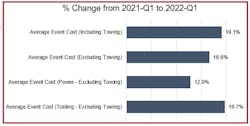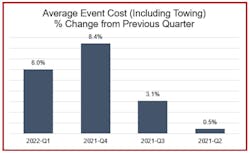Roadside breakdown services: Lifelines that rescue truckers
It’s 2 a.m. It’s dark and something has happened to your tractor-trailer, causing you to be stranded out in the middle of nowhere, hundreds of miles from headquarters. Meanwhile, cargo is waiting in the trailer behind you to be delivered far from this unfamiliar place. That freight may even be perishable and would be undeliverable if it doesn’t reach its destination soon. Who are you going to call?
It might not be a matter of a call. Hailing emergency breakdown services sometimes is about logging onto an app you already use in your trucking life or jumping on a familiar website that will direct you to much-needed assistance. These services will have roadside help for you within the hour, if possible, however, you request it. They’re all aimed at truckers and fleet managers in desperate need, and they’re all designed to get you back on the road as quickly as possible. Uptime = good. Downtime = very bad.
And technicians also are in short supply, so fleets are lengthening service intervals for their equipment, making breakdowns even more likely. Hence, equipment is at risk of breaking down, so the many services to extricate drivers and fleets from these sticky situations have become more important than ever.
Fewer new trucks and trailers, more costs, and breakdowns
In July, the latest month of available data, Class 8 tractor orders were way down, according to industry researchers FTR Transportation Intelligence and ACT, with FTR reporting July orders (10,600 units) at their lowest level since November 2021—that's almost 10 months. Both research firms said OEMs have run out of build slots for 2022 and are not yet entering orders for 2023, meaning new equipment will be slow to come to the industry for quite some time.
According to FleetNet America's latest Vertical Benchmarking report for the first quarter of 2022, which FleetNet compiles with American Trucking Associations' Technology & Maintenance Council, the pressure on the maintenance sector is severe, and the need for unscheduled roadside assistance and repairs is higher than perhaps ever in this climate. And the costs of both repairs and roadside assistance also are surging.
Inflation, increasing labor costs, high fuel prices, and supply chain challenges are all driving maintenance costs higher, according to the report.
"Obviously, there are some inflationary pressures on the business," Tim Moore, VP of TMcare Operations at FleetNet America, said in the executive summary of the report, which also emphasizes the need for fleets to double their efforts in preventive maintenance (with tires, lighting, and brakes especially) to reduce the need for emergency breakdown services and unscheduled repairs.
The FleetNet report has some eye-opening data about how costs are increasing. The average cost per event, excluding towing, for the first quarter of 2022 increased 16.6% over Q1 last year, according to the report. Both power and trailing equipment increased each quarter at similar rates until this quarter, when trailing increased 6% over Q4 2021. And the average cost per event, including towing, increased 19.1% for the first quarter over Q1 2021, according to the report.
See also: ATRI: Trucking endures 'costliest year ever'
Power only, or roadside assistance and repairs for trucks alone, increased 1.9% over the fourth quarter of last year. Overall, the "event cost" for trailers, excluding towing, was up 19.7% in Q1 2022 over Q1 2021. The average event cost for power units, excluding towing, was up 12.9% in Q1 2022 from Q1 2021.
Many fleets are keeping equipment longer than they have in the past, which is having a direct impact on maintenance costs and, therefore, the need for breakdown services, Moore said in the report.
"The older it gets, the more maintenance becomes an issue," he said,
adding that the cost of diesel and the labor shortage is increasing roadside repair expenses. "For service providers, fuel costs hit them as well."
Emergency roadside services: How they get on-scene
In this atmosphere where breakdowns are more likely, professional drivers, fortunately, have more options than ever in reaching emergency roadside services. Some of these services are app-based, many are both app- and web-based, and all are just a cellphone call away. Truck driving is an especially difficult job—and all the companies that FleetOwner contacted emphasized that their No. 1 job is—as painlessly as possible—bailing truckers out of stressful situations.
"Speed and urgency. That's at the top of our call," said Scott Higgs, assistant VP of vehicle operation at Cox Automotive Mobility Fleet Services of Dickinson Fleet Services, which is a "brick-and-mortar operation" hailed by app, website, or phone with more than 1,000 service trucks that operate out of the lower 48 states and 22 service locations with five to 30 service technicians in each location.
Dickinson's mobile roadside assistance vehicles are available 24/7/365, according to Higgs. Dickinson services 8,000-plus fleets nationwide and performs more than 500,000 repairs annually. The company performs what it calls "dedicated on-site," where 300 or so of its units go and stay at fleet terminals to perform scheduled service. Their motto is "Cox Mobility, when speed and urgency matters," he said.
Meanwhile, ServiCase is more like a go-between—a search tool between service providers and fleets and drivers. It's like Uber for emergency breakdown services, said Jeffrey Godwin, president of FTI Groups and VP of software solutions for FleetNet America, which owns ServiCase. "Tools like this just help us connect better to the service provider community. Our role is really about supporting service providers," Godwin told FleetOwner.
See also: The benefits of on-site maintenance
ServiCase allows fleets to register for free, and it's a web-based breakdown management system that provides carriers and small fleets the ability to electronically search for providers, dispatch roadside retrieval jobs, and track events, according to Godwin and the ServiCase website. It provides access to thousands of registered towing, mechanic, and roadside service providers and will digitally dispatch the service request when a provider is connected. ServiCase provides not only 24-hour towing and recovery but also truck repair, maintenance, and commercial tire repair and replacement.
ServiCase also is a free breakdown management system that allows fleet managers to track ETAs to a service location through completion of the job, including event status, photos, invoicing, ratings, and private notes. Service providers upload their locations, rates, and insurance providers, and the service does the rest, Godwin said. ServiCase can even be integrated into mobile apps so carriers can log in and manage their own reports on breakdown events, he said.
"This is something that the market has been requesting for a while. The biggest thing these customers need is more real-time information. They don't want to find out the price of an event two weeks later. Everybody is looking for 'Uber-ization,'" he said, and ServiCase provides just such a service to fleets and professional drivers.
Tires, unsurprisingly, are the most common cause of breakdown events to which Dickinson and ServiCase respond, Higgs and Godwin both noted.
About the Author
Scott Achelpohl
Managing Editor
Scott Achelpohl is a former FleetOwner managing editor who wrote for the publication from 2021 to 2023. Since 2023, he has served as managing editor of Endeavor Business Media's Smart Industry, a FleetOwner affiliate.




